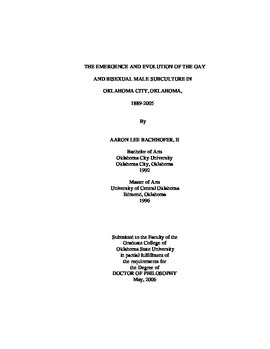| dc.contributor.advisor | Belmonte, Laura A. | |
| dc.contributor.author | Bachhofer, Aaron Lee, II | |
| dc.date.accessioned | 2013-11-26T08:24:14Z | |
| dc.date.available | 2013-11-26T08:24:14Z | |
| dc.date.issued | 2006-05 | |
| dc.identifier.uri | https://hdl.handle.net/11244/6776 | |
| dc.description.abstract | Scope and Method of Study: This dissertation traces the development of the gay and bisexual male subculture in Oklahoma City, Oklahoma, 1889-2005. Utilizing a variety of primary materials -- newspapers, sodomy court records, personal interviews, and census records -- the author reconstructed the social and sexual lives of gay and bisexual residents. Further, a comparison between Oklahoma City's queer subculture and those found in larger metropolitan areas was made throughout to test the validity of assumptions regarding the roles played by geography, urbanization, World War II, and Civil Rights-era protests on the growth of gay and bisexual subcultures. | |
| dc.description.abstract | Findings and Conclusions: Research indicated that a diverse gay and bisexual world existed in Oklahoma City with roots that extended back before World War II. That subculture included well-known spots for sex and socialization, openly-gay residents, and it operated rather openly until the late 1950s. At that juncture, a sundry of factors--the end of state-mandated prohibition, public outcries over vice, and the election of a homophobic county attorney---allowed authorities to pursue vice more fervently, and it forced many gay and bisexual men back into the closet. Although Oklahoma City did not have a "Stonewall" moment, political activism was not absent in the 1970s and 1980s. Serious grass-roots politicization occurred in response to an Oklahoma legislator's attempt to deny homosexuals the right to teach in public schools, to combat police brutality, and to fight AIDS. Yet recent events, such as Oklahoma's prohibition against same-sex marriage, adoptions, and any antidiscrimination measures that local governments might enact, overshadowed that tradition of activism. This represents a fundamental weakness in the gay and bisexual Oklahoma City community---an unwillingness to meet macro-issues affecting homosexuals across the United States---and it stems from the openness that subculture enjoyed into the 1950s. | |
| dc.format | application/pdf | |
| dc.language | en_US | |
| dc.rights | Copyright is held by the author who has granted the Oklahoma State University Library the non-exclusive right to share this material in its institutional repository. Contact Digital Library Services at lib-dls@okstate.edu or 405-744-9161 for the permission policy on the use, reproduction or distribution of this material. | |
| dc.title | Emergence and evolution of the gay and bisexual male subculture in Oklahoma City, Oklahoma, 1889-2005 | |
| dc.contributor.committeeMember | Williams, Elizabeth A. | |
| dc.contributor.committeeMember | Logan, Michael F. | |
| dc.contributor.committeeMember | Bays, Brad A. | |
| osu.filename | BachofferII_okstate_0664D_1706.pdf | |
| osu.accesstype | Open Access | |
| dc.type.genre | Dissertation | |
| dc.type.material | Text | |
| dc.subject.keywords | gay | |
| dc.subject.keywords | bisexual | |
| dc.subject.keywords | oklahoma | |
| dc.subject.keywords | history | |
| dc.subject.keywords | queer politics | |
| thesis.degree.discipline | American History | |
| thesis.degree.grantor | Oklahoma State University | |
